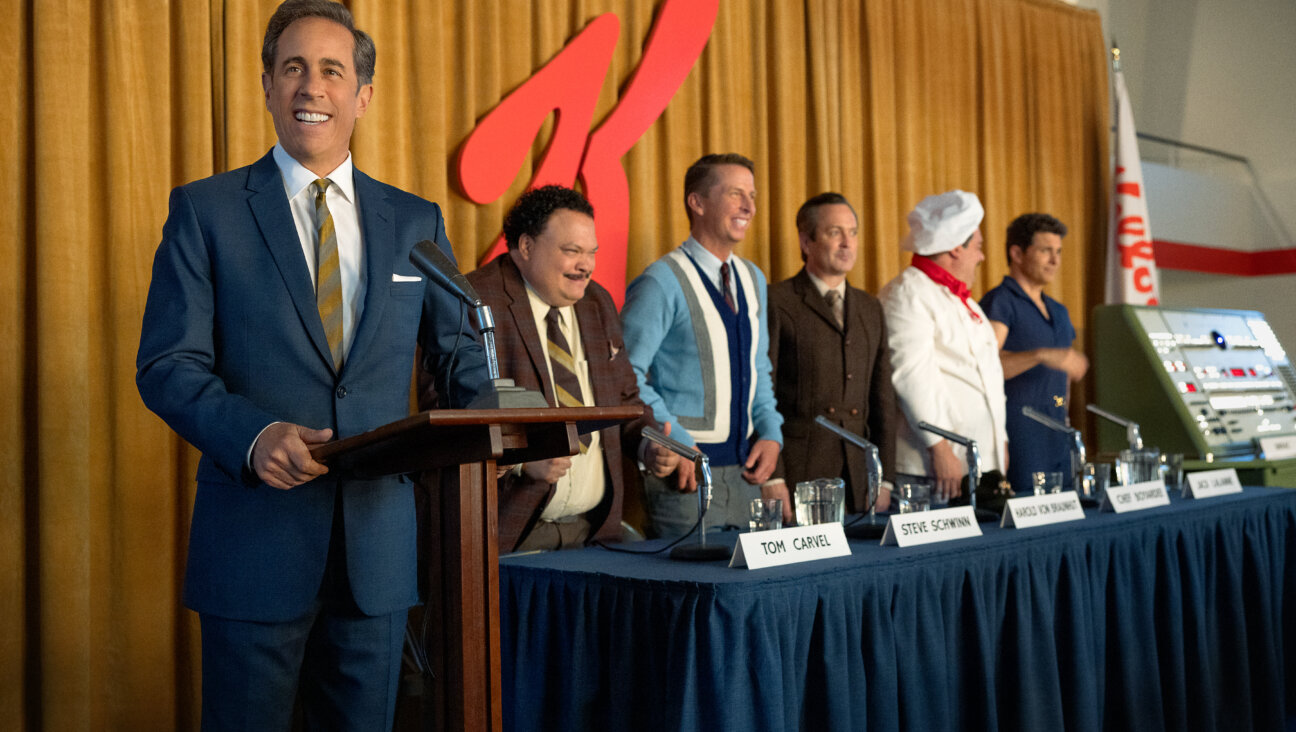Buildings That Jump Up And Bite

Architecture of Joy: Although grand, luxurious works did not constitute Morris Lapidus? whole oeuvre, he is well-known for his Miami hotels like Eden Roc and the Fontainebleau, pictured above. Image by Courtesy of FontaineBLEAU HOTEL
Modern architects such as Frank Lloyd Wright and Le Corbusier are notorious for having fixed, even tyrannical, ideas of how people should experience the buildings they designed — sometimes seemingly for maximum discomfort. Breaking with this precedent, architect Morris Lapidus, born in Odessa to an Orthodox Jewish family in 1902, designed buildings to make people happy.
By putting people first, Lapidus has charmed a new generation of admirers, that has dedicated recent tributes to his work, such as the strikingly illustrated “Morris Lapidus: The Architecture of Joy” by Deborah Desilets (Rizzoli Publishing, 2010), and a 2010 gallery exhibit, “Morris Lapidus: A Quest for Emotion and Motion in Architecture,” at Miami Beach’s Art Center / South Florida.
Lapidus, who died in 2001 at age 98, was a quintessentially American architect whose buildings embody the right to “the pursuit of happiness” asserted by the Declaration of Independence. Although mostly renowned for his Floridian exuberance, he also designed stores and hotels in Brooklyn; Washington, D.C., and beyond, including London’s Portman Square Hotel.
Enjoyable though his creations might be, his methods were far from frivolous. An extremely diligent and highly serious craftsman, Lapidus evolved some basic theories, such as what he called the “moth principle,” that people are drawn to well-lit areas, or that they prefer to wander along curved lines rather than walk in straight lines in boxlike rooms. Lapidus’s fundamental approach to interior decoration is summed up in the title of his 1996 memoir, “Too Much Is Never Enough: The Autobiography of Morris Lapidus, Architect.”
Lapidus designed from the mindset of his generation of postwar Jews, many of whom emerged from humble origins and who sought an unrestrained celebration of the good life, as represented by Miami in the 1950s and ’60s. Lapidus’s over-the-top 1954 Fontainebleau Hotel — celebrated in a book by Kevin and Rebecca Plotner, “The Fontainebleau Miami,” (Schiffer Publishing, 2008) — has come to symbolize a certain sensibility associated with, but actually preceding, the Rat Pack. The Fontainebleau is itself a star, having been featured in the 1959 Frank Sinatra film “A Hole in the Head;” the 1960 Jerry Lewis comedy “The Bellboy;” the 1964 James Bond movie “Goldfinger,” and more recently as the temporary shelter of Tony Soprano, the gangster profoundly obsessed by Rat Pack culture, in a 2002 episode of HBO’s “The Sopranos.”
Basically, Lapidus wanted people to enter the lobbies of his Miami hotels, such as the Fontainebleau and 1955’s Eden Roc, and plotz with delight — and mostly they did. Critics and architecture professionals, however, reacted with scorn. Architecture critic Ada Louise Huxtable wrote, in The New York Times in 1954: “Lapidus has elevated a kind of taste to a kind of art, even if it is made of plastic, mirrors, and spit — it is still uninspired super-schlock.” Huxtable (née Landman), was the niece of Rabbi Isaac Landman, a prominent anti-Zionist who served Brooklyn’s Congregation Beth Elohim from the 1930s onward. Perhaps she was subliminally expressing the fear that anything too overtly Jewish, too expressively flamboyant, must be suppressed as a potential shonda.
Yet Lapidus’s byword was “Express, don’t suppress.” The Fontainebleau and Eden Roc lobbies featured grandiose staircases whose only function was to serve as a place for people to slink up and down, showing off their furs and jewelry, and pose for commemorative photos. What became known as “staircases to nowhere” were hugely popular and may even have partly inspired Sheldon Harnick’s lyric for the 1964 hit song “If I Were a Rich Man,” from “Fiddler on the Roof.” In the lyric, Tevye, while experiencing desperate shtetl poverty, fantasizes about building a mansion with two staircases, one leading up and one leading down, and “one more leading nowhere, just for show.” Lapidus’s “just for show” staircases are tangible versions of this Tevye-like fantasy of no longer having to struggle for the bare necessities and being able to indulge in superfluous excess.
Finally, in his 90s, Lapidus won praise from critics and colleagues. When presented with an “American Original” National Design Award at Cooper Union in 2000, he explained how his family came to America because of his mother’s determination to take her son “out of this horrible country of Czarist Russia with its persecution of the Jews.” When he arrived in Williamsburg and registered for school, his given name, Moise, was Americanized as Morris, and he soon became bewitched by the idea of becoming a stage designer. His architectural studies, required for working in the theater, led to a job designing shops, where, he told the Cooper Union audience, he addressed the problem of “How do I attract people to stop and come into my stores?”
To achieve this goal, he followed some classic concepts from the ancient Roman architect Vitruvius, who suggested that architecture should contain “firmness, fitness and delight.” Yet firmness was not rigidity, as Lapidus continued: “I personally always disliked boxes. I preferred flowing, sweeping, unusually designed stores. When I began to design buildings, I thought, soldiers walk in straight lines, but people meander.”
Grand, luxurious hotels did not constitute his whole oeuvre. Belying his taste for meandering, Lapidus was also a master of utilitarian architecture, as Deborah Desilets’s book demonstrates with reproductions of his synagogue designs, such as his 1961 Temple Beth Tfiloh in Pikesville, Md., with its soaringly aspiring ceiling. Or 1962’s Temple Menorah in Miami Beach, where the building’s accessible-looking exterior, instead of being fortresslike as is often the case in sacred architecture, is a porous surface resembling a loudspeaker that freely communicates the spiritual treasures within. This joyful, welcoming approach to synagogue design placed a firm emphasis on hospitality, as did all of Lapidus’s work.
His 1945 design for his own New York architecture offices welcomes the visitor with a jaunty visual pun: The office door is covered with a collage of blueprints, something like a Dadaist creation by Kurt Schwitters, and in place of a doorknob, there’s a T-square, the technical drawing instrument found in every architect’s office. Lapidus’s 1963 interior designs for his Miami apartment similarly roll out the welcome mat with a wildly exuberant, gilded décor, a blindingly bright master bathroom fit for a Folies-Bergère star, and, in the living room, that quintessential detail of 1960s Jewish homes: plastic armrest covers to protect the upholstery.
Lapidus was much more than just a Miami creator, as Desilets stresses. He also designed housing projects and hotels across America and abroad, including a community recreation center in Brooklyn’s Bedford-Stuyvesant in 1967. On Manhattan’s East Side, he created the Summit Hotel in 1959 (now the DoubleTree Metropolitan). The jubilant building expresses Lapidus’s trademark vitality despite being restricted by what he told the developer was a “ridiculously small space, limited by height and space.” Almost all of Lapidus’s work has this quality of being alive, which inspired Scottish architect Basil Spence to announce, upon seeing Lapidus’s 1956 Americana Hotel in Bal Harbour, Fla.: “I thought [the hotel] was going to jump up and bite me.”
Benjamin Ivry is a frequent contributor to the Forward.
Watch Morris Lapidus interviewed in 1999:

I hope you appreciated this article. Before you go, I’d like to ask you to please support the Forward’s award-winning, nonprofit journalism during this critical time.
Now more than ever, American Jews need independent news they can trust, with reporting driven by truth, not ideology. We serve you, not any ideological agenda.
At a time when other newsrooms are closing or cutting back, the Forward has removed its paywall and invested additional resources to report on the ground from Israel and around the U.S. on the impact of the war, rising antisemitism and the protests on college campuses.
Readers like you make it all possible. Support our work by becoming a Forward Member and connect with our journalism and your community.
Make a gift of any size and become a Forward member today. You’ll support our mission to tell the American Jewish story fully and fairly.
— Rachel Fishman Feddersen, Publisher and CEO
Join our mission to tell the Jewish story fully and fairly.
























